Read "DTC Status" parameter.


A Crankshaft Position Sensor (CKPS) is a magnetic type sensor that generates voltage using a sensor and a target wheel mounted on the crankshaft; there are 58 slots in the target wheel where one is longer than the others. When the slot in the wheel aligns with the sensor, the sensor voltage outputs low. When the metal (tooth) in the wheel aligns with the sensor, the sensor voltage outputs high. During one crankshaft rotation there are 58 rectangular signals and one longer signal. The PCM calculates engine RPM by using the sensor’ s signal and controls the injection duration and the ignition timing. Using the signal differences caused by the longer slot, the PCM identifies which cylinder is at top dead center.
If the number of input signal between the standard positions is larger than the normal value over 7 times, PCM sets DTC P0338.
Item | Detecting Condition | Possible Cause |
DTC Strategy | ● Reference mark check | ● Poor connection ● Open or short in signal circuit ● CKPS |
Enable Conditions | ● Vehicle speed 〈 1kph or 〉25kph ● Engine speed 〉 Idle speed | |
Threshold Value | ● 1 more tooth detected | |
Diagnostic Time | ● More than 7 times | |
MIL ON Condition | ● 2 driving cycle |
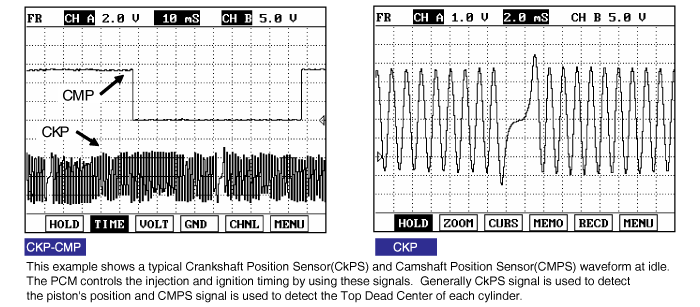
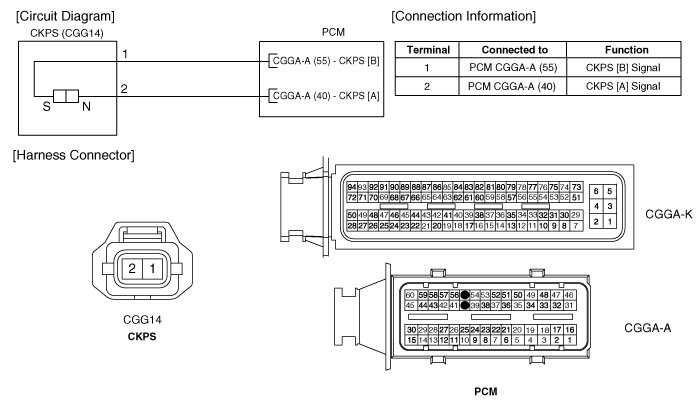
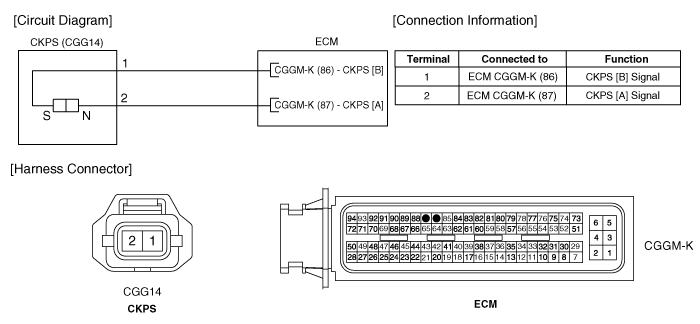
Connect scantool to Data Link Connector(DLC).
IG "ON".
Select "Diagnostic Trouble Codes(DTCs)" mode, and then Press F4(DTAL) to check DTC'sinformation from the DTCs menu
Confirm that "DTC Readiness Flag" indicates "Complete". If not, drive the vehicle within conditionsnoted in the freeze frame data or enable conditions noted in the DTC detecting condition.
Read "DTC Status" parameter.

Is parameter displayed "History(Not Present) fault"?
History fault : DTC occurred but has been cleared.
Present fault : DTC is occurring at present time.

▶ Fault is intermittent caused by poor contact in the sensor’s and/or ECM’s connector or wasrepaired and ECM memory was not cleared. Thoroughly check connectors for looseness,poor connection, bending, corrosion, contamination, deterioration, or damage.Repair or replace as necessary and then go to "Verification of Vehicle Repair" procedure.

▶ Go to "Terminal & Connector Inspection" procedure
Many malfunctions in the electrical system are caused by poor harness and terminals. Faults can also be caused by interference from other electrical systems, and mechanical or chemical damage.
Thoroughly check connectors for looseness, poor connection, bending, corrosion, contamination, deterioration, or damage.
Has a problem been found?

▶ Repair as necessary and go to "Verification of vehicle Repair" procedure.

▶ Go to "CKPS circuit inspection" procedure.
Check Oepn in signal circuit.
Key "OFF".
Disconnect CKPS connector.
Key "ON".
Measure the voltage between terminal 1 / 2 of CKPS harness connector and chassis ground.
Specification : Approx 2.5V
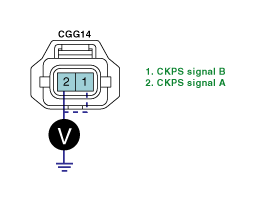
Is the measured voltage within specification?

▶ Go to "Check Short in signal circuit" procedure.

▶ Repair Open in signal circuit and then, go to "Verification of Vehicle Repair" procedure.
Check Short in signal circuit.
Key "OFF".
Disconnect CKPS connector and ECM connector.
Measure the resistance between 1 and 2 of CKPS harness connector.
Specification : Infinite
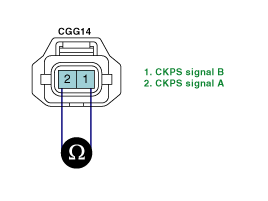
Is the measured resistance within specifications?

▶ Go to "Component inspection" procedure.

▶ Repair Short in signal circuit and then, go to "Verification of Vehicle Repair" procedure.
Check CKPS.
Key "ON". (Don't disconnect sensors.)
Select "vehicle scopemeter" in the menu, and connect channel A of scantool with terminal 1 of CKPS harness connector.
Engine start. And check the signal waveforms.

Is the measured signal waveform O.K?

▶ Many malfunctions in the electrical system are caused by poor harness(es) and terminals. Faults can also be caused by interference from other electrical systems, and mechanical or chemical damage. So, check poor connections and the related circuit between ECM and component thoroughly. Repair as necessary and go to "Verification of Vehicle Repair" procedure.

▶ Substitute with a known - good CKPS and check for proper operation.
▶ If the problem is corrected, replace CKPS and go to "Verification of Vehicle Repair" procedure.
After a repair, it is essential to verify that the fault has been corrected.
Connect scan tool and select "Diagnostic Trouble Codes(DTCs)" mode.
Press F4(DTAL) and confirm that "DTC Readiness Flag" indicates "Complete".
If not, drive the vehicle within conditions noted in the freeze frame data or enable conditions.
Read "DTC Status" parameter.
Is parameter displayed "History(Not Present) fault"?

▶ System performing to specification at this time. Clear the DTC.

▶ Go to the applicable troubleshooting procedure.